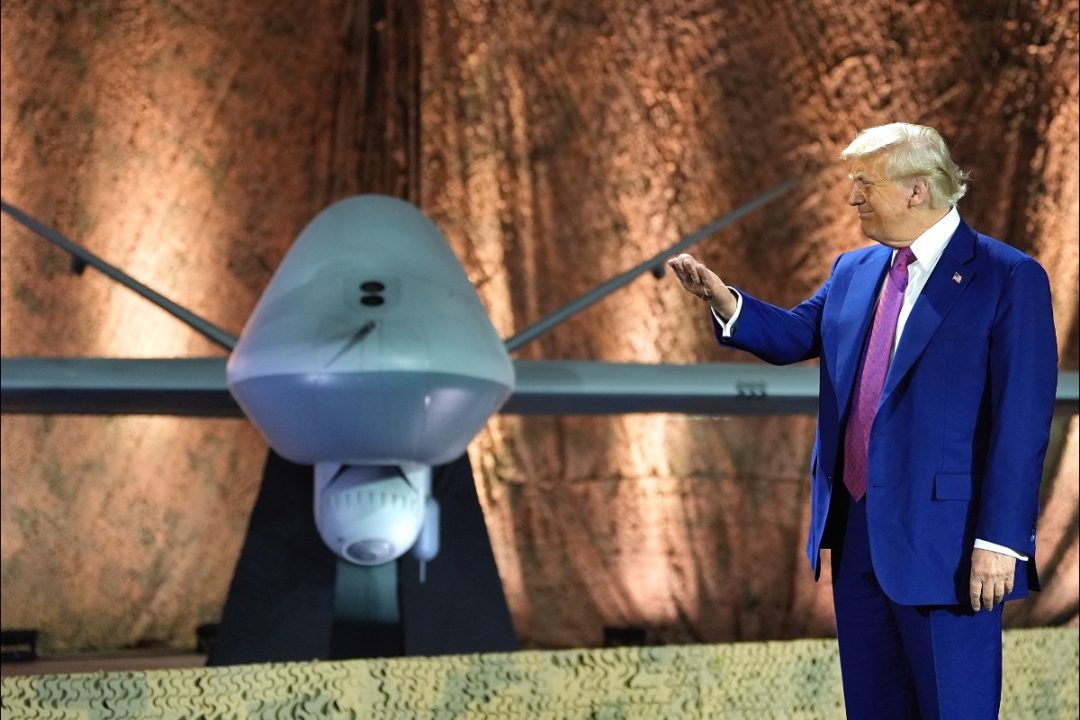Trump’s Plan to Reinterpret Arms Treaty and Boost Drone Sales

AP Images
The Policy Shift
In a significant move that is capturing headlines, President Donald Trump intends to reinterpret a decades-old arms control treaty, potentially unlocking a wave of drone sales for the U.S. military industry. A pivotal aspect of this plan involves Saudi Arabia’s request for over 100 MQ-9 Reaper drones, as reported on Reuters. This reinterpretation could form part of a much larger $142 billion arms deal that was announced earlier this year.
For those anticipating a shift in America’s militaristic approach, this news may seem disheartening. The reinterpretation portrays unmanned aerial vehicles not as instruments of war but as commodities ripe for commercialization.
Understanding the Treaty
The Missile Technology Control Regime (MTCR) was established in 1987 among 35 countries to prevent the proliferation of delivery systems for weapons of mass destruction. The treaty categorizes unmanned aerial vehicles (UAVs) into two classes:
- Category I: This includes complete missiles or UAVs capable of carrying significant payloads over long distances. Exports in this category face strict scrutiny and a “strong presumption of denial.”
- Category II: Shorter-range systems and dual-use components that can be exported with regulatory oversight.
In recent years, advancements in UAV technology led many MTCR members to classify larger drones, like the MQ-9 Reaper, under Category I, significantly limiting U.S. export potential.
The Reclassification Strategy
Trump’s administration is proposing a crucial semantic shift: classifying drones as “aircraft” rather than missile systems. This move would effectively place them under the Foreign Military Sales (FMS) process, creating a pathway for streamlined approvals and bypassing the stringent regulations of the MTCR. U.S. officials argue that this reinterpretation is essential for bolstering the defense industry and counteracting competition from countries like China and Turkey, whose drone exports are less constrained.
By treating drones as commodities instead of restricted military assets, the administration is promoting an environment where arms can flow with greater ease, potentially prioritizing profits over restraint.
How Foreign Military Sales Operate
The Foreign Military Sales (FMS) program is a structured approach through which foreign governments acquire U.S. weapons. The procedure begins with a Letter of Request from a foreign government, followed by a Letter of Offer and Acceptance from the U.S. If both parties agree, the Pentagon manages the contract, ensuring that all costs, including administrative fees, are covered by the buyer.
In essence, this procedure transforms arms exportation into a government-sanctioned endeavor, shifting the responsibility of pricing, vetting, and delivering weapons to the state. This could substantially influence military sales to countries eager to bolster their defense capabilities.
The Capabilities of Drone Technology
A key component of this discussion is the MQ-9 Reaper drone itself, a formidable aerial combat vehicle rather than a simple surveillance tool. With the ability to carry up to 3,750 pounds over a range of approximately 1,150 miles, the Reaper is a persistent strike platform capable of precision assault.
The Reaper’s design allows for stealth operations, enabling it to carry out strikes while remaining undetected, highlighting the challenges faced in regulating such powerful technology. It embodies the type of weaponry the MTCR aims to restrict due to its potential for wide-range proliferation.
Beneficiaries of the Policy Change
The reinterpretation of the treaty presents significant financial opportunities for various companies, most notably General Atomics, the manufacturer of the MQ-9 Reaper. With the current export restrictions, the financial prospects for selling a full Reaper system—which can exceed $5 billion per contract—have been exceptionally limited.
In addition to General Atomics, other drone manufacturers like Kratos and Anduril may also see advantages from this policy shift, even if their technologies currently fall under less-restrictive licensing rules.
Trump’s Executive Orders
In a bid to fast-track advancements in drone technology, Trump recently signed executive orders aimed at easing operational regulations. These directives push the FAA to relax rules governing beyond-visual-line-of-sight flights and explore emerging technologies such as electric vertical take-off and landing aircraft.
By positioning these efforts as initiatives to enhance U.S. aerospace dominance, the administration paints a picture of innovation. Yet, a closer examination reveals a deliberate venturing into state-sponsored sales strategies that align government goals with corporate interests, redefining the landscape of arms exports.
This analysis demonstrates a growing trend wherein the lines between arms control, technological innovation, and corporate profit become increasingly blurred. By reinterpreting treaties and streamlining sales processes, the administration is instigating a paradigm shift toward a more militarized and commercially-driven approach to drone sales, reshaping not just foreign policy but also the very nature of global arms trading.

